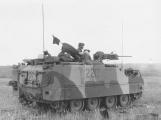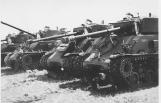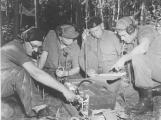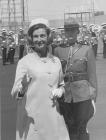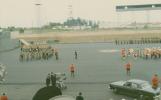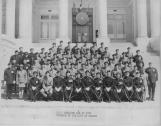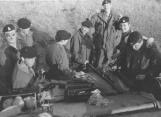14
This is a Staghound armoured car, used by the recce troop of an armoured squadron.1957
Glenemma Range, Glenemma, BC, Canada
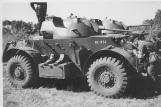
16
Troops in the field need hot food to stay sharp during training periods.1965
Glenemma Range, Glenemma, BC, Canada
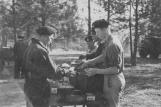
17
Ferret equipped recce troop out on a route reconnaissance exercise.1968
Somewhere in the Okanagan Valley, BC, Canada
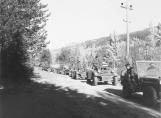
22
The new Guidon is 'Trooped' during the Freedom of the City of Kelowna parade.July, 1967
Kelowna, BC, Canada
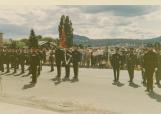
23
In 1971, the Dragoons were honoured with the 'Freedom of the City' of Vernon in conjunction with the province's Centennial celebrations. In attendance were the Provincial Minister of Tourism, Honorary Colonel MGen Pearkes and Honorary LCol., Commander J. Bruce Smith.In September 1972, 'A' and 'B' Squadrons vied for the Ogopogo Lake Challenge Trophy awarded to the 15 man crew of a rubber raft from each squadron who completed the two-day paddle on Okanagan Lake, from Okanagan Landing to Kelowna - a distance of 30 miles - in the shortest time. The teams departed on a Saturday morning to paddle the 24 miles to Wilson's Landing. The next morning the somewhat stiffened crews were once again on the water for the final stretch to Kelowna, where the rafts were landed at the boat-launch ramp and portaged to finish line at the Armoury several blocks away.
In the 1970s the BCDs sent two formed troops to Germany. In 1978 the second troop's deployment, its commander, Lt. Bruce MacLean, was killed in an accident. He was the first fatality since Brig. H. Angle had died in the Kashmir. In honour of Lt. MacLean, there is a trophy awarded annually for the best junior officer in the unit. In 1977, the Regiment won the coveted Worthington Trophy for the unit that attained the highest overall standard in the Royal Canadian Armoured Corps. A national competition, it is presented in honour of MGen. F. F. Worthington, who was the first commander of the Canadian Armoured Fighting Vehicles Training Centre and the "Father" of the Corps.
The Dunwoody trophy was awarded to the Militia unit attaining the highest overall standard in the Prairie and Pacific Areas. The BCDs won it in 1966 and again in 1975 and the next three years straight.
In 1978 and 1979, the Regiment won the Murphy Trophy, in honour of BGen. W. C. Murphy who was a former wartime Commanding Officer of the BCDs. This trophy was first presented in 1953 to the best unit at the summer camp in Western Command and was for a time thereafter, conferred upon the unit found to be the finest Recce regiment in the country. Latterly, it has come to be awarded to the runner-up to the Dunwoody Trophy winner.
Mayor J. Hindle of Kelowna presented the City of Kelowna Flag to the Regiment to mark the unit's 70th Anniversary in 1978.
In 1981, after several years as Recce, the BCDs once again became a tank regiment. Its tasking with respect to the Lord Strathcona's Horse (RC), (LdSH), a western Canadian Regular unit that the BCDs would augment in an emergency, was modified to require the Regiment to provide half a tank squadron, as well as Recce troops.
The signal that the Dragoons would be converting, to some extent from 'sneak and peek' Recce tasks to a full battle tank role was the arrival in the summer of 1981 of the four Cougar Armoured Vehicle, General Purpose (AVGP) tank trainers. These became the focus of unit training. The Cougar is a based on a Swiss designed, Canadian built, six-wheeled armoured vehicle with a British Scorpion Turret with a 76mm main gun. The three-man crew consists of a Driver, Gunner and Crew Commander/Loader. The vehicle was fully amphibious and powered in water by two permanently mounted propellers. Its engine is silent to the human ear at 100 metres and will accelerate from 0-50 kph in 10 seconds with a recommended top speed of 90 kph, although legend has it that a Washington State Highway Patrol trooper once clocked a BCD cougar doing about 100 kph (or 70 mph) on the road approaching the Yakima Gunnery Range. LCol. E. B. Collet, who was a former BCD trooper, was the chief of the research team that studied the Swiss Mowag design and recommended it for the Canadian Army.
24
Officers of the BCDs at the time of the annual inspection, this time in the field, at Glenemma.24 May 1970
Glenemma Range, Glenemma, BC, Canada
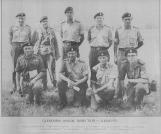
26
This is a 'Lynx' light tracked reconnaissance vehicle.1971
Sarcee Range, Calgary, Alberta, Canada
